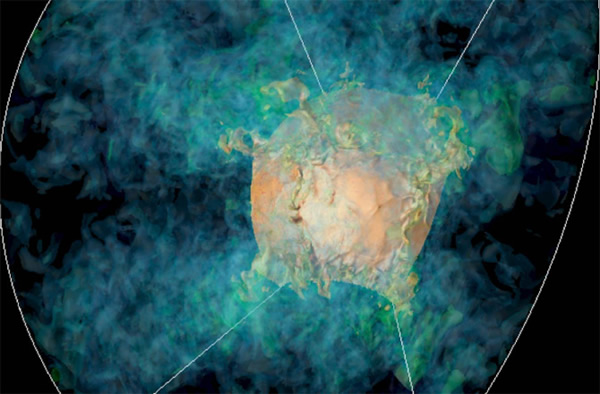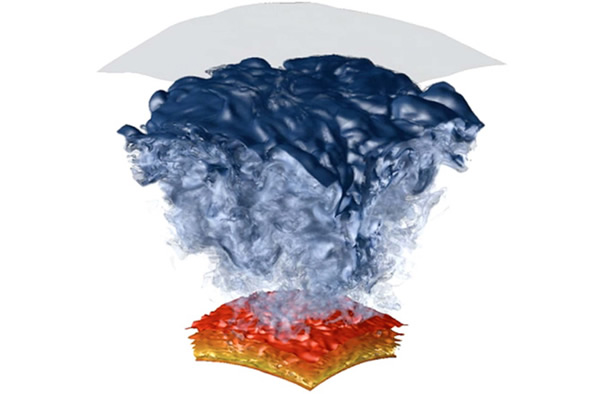Simulation Gives Glimpse into Supernova's Chaotic Guts
Three-dimensional turbulent mixing in a stratified burning oxygen shell. The yellow ashes of sulfur are being dredged up from the underlying orange core.
Supernovae are the deaths of massive stars that give birth to heavy elements, more stars, planets and, ultimately, life. These most violent explosions are the foundation for all the stuff we see in the Universe, but for such a fundamental phenomenon we know very little about how and why they ‘blow.’
In a new study by an international team of astrophysicists, a sophisticated computer simulation has been created in an effort to understand the 3-dimensional complexities inside a supernova. As expected, the dynamics in the guts of a collapsing star are complex, but this new model gives scientists the best ever look at how matter mixes when the supernova detonates, potentially explaining observations of supernovae that haven’t quite fitted our understanding of how we thought these gargantuan explosions worked.
In 1987, a supernova (1987A) detonated in the Large Magellanic Cloud, a nearby dwarf galaxy only 168,000 light-years away. This event caused some confusion in the astronomical community — like many cosmic phenomena, the observation didn’t quite match with our theoretical expectations. When studying the expanding cloud of supernova debris, astronomers noticed that material freshly ejected from the explosion was mixing with material the progenitor star had ejected some time before. This mixing was unexpected, suggesting that theoretical models needed refining.
Existing models assume a concentric, ‘shell-like’ structure of differentiated elements inside a star that is about to go supernova. As the massive star collapses under gravitational contraction (after exhausting its fusion fuel in the core), copious amounts of neutrinos are generated, rapidly leaching energy from the star’s interior. This has the effect of speeding up the contraction, accelerating the heating.
“It heats up and burns faster, making more neutrinos and speeding up the process until you have a runaway situation,” said W. David Arnett, of Astrophysics at the University of Arizona.
In an effort to understand this process, astrophysicists have turned to supercomputers for help. Often, because of technological restrictions, researchers will create a 1-D or 2-D model and make assumptions on the other dimensions. While this is effective, it often leads to a smooth transition between the layers inside the supernova. But this only tells half the story.
Snapshot of the simulation showing oxygen burning in a moderately stratified shell during a supernova.
Arnett is working with Casey Meakin and Nathan Smith, also at at the University of Arizona, and Maxime Viallet of the Max-Planck Institut fur Astrophysik, Germany, to develop a fully 3-dimensional model of a supernova. Their work now provides us with an even more violent and chaotic view of how a supernova detonates.
“We still have the concentric circles, with the heaviest elements in the middle and the lightest elements on top, but it is if someone put a paddle in there and mixed it around,” said Arnett. “As we approach the explosion, we get flows that mix the materials together, causing the star to flop around and spit out material until we get an explosion.
“That’s what see in supernova remnants, we see those ejections of star material, and how they mix with material expelled from the star during its final explosion. Other models cannot explain this,” he said.
With the help of supernova surveys, such as the Katzman Automatic Imaging Telescope (KAIT) and Palomar Supernova Factory, observations of stars as they become unstable and explode as supernovae are becoming more detailed, providing an unprecedented look into the death of stars. Interestingly, it’s not all about the massive explosion, the run-up to a supernova features many stellar complexities.
“Instead of going gently into that dark night, (the star) is fighting. It is sputtering and spitting off material. This can take a year or two. There are small precursor events, several peaks, and then the big explosion,” added Arnett. “Perhaps we need is a more sophisticated notion of what an explosion is to explain what we are seeing.”
Publication: Chaos and turbulent nucleosynthesis prior to a supernova explosion, Arnett, Meakin and Viallet, 2014. DOI: 10.1063/1.4867384
Source: Physorg.com, American Institute of Physics(Mar 19, 2014 01:34 PM ET // by Ian O'Neill)













